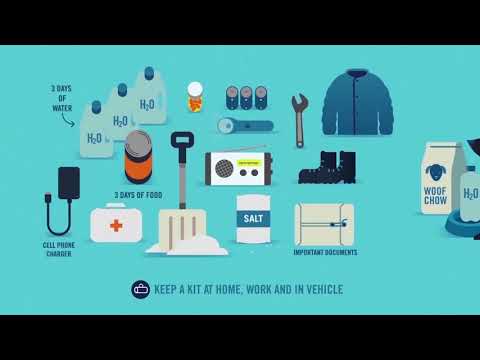HOUSTON – The Federal Emergency Management Agency (FEMA) has introduced the #WinterReady campaign to assist individuals in preparing for freezing temperatures. This initiative is especially critical for people with disabilities and older adults who are frequently left without support.
Winter storms pose several serious threats, including the risk of carbon monoxide poisoning due to power outages, as well as the dangers of hypothermia, frostbite, and negative impacts on mental health.
Winter storms can be unpredictable and dangerous, so it’s important to be prepared. Here are some tips on how to get ready for a winter storm:
- Stay informed: Keep an eye on weather forecasts and updates to stay informed about the approaching storm. This will help you plan and take necessary precautions in advance.
- Stock up on essentials: Make sure you have an ample supply of food, water, and necessary medications to last for several days. It’s also a good idea to have extra batteries, flashlights, and a battery-powered radio.
- Insulate your home: Ensure that your home is properly insulated to keep the cold air out and the warm air in. Seal any cracks or gaps around windows and doors, and consider using draft stoppers to prevent drafts and heat loss.
- Prepare your car: If you have to travel during a winter storm, make sure your car is ready. Keep your gas tank full, check the tire pressure, and have an emergency kit in your vehicle. This kit should include items like a blanket, extra clothing, a shovel, and a first aid kit.
- Create an emergency plan: Discuss with your family what you will do in case of a power outage or other emergency situations. Have a designated meeting place and a communication plan, and make sure everyone knows what to do.
- Stay indoors: During the storm, it’s best to stay indoors and avoid unnecessary travel. If you must go outside, dress in warm layers and wear appropriate footwear to prevent slips and falls.
Remember, preparation is key when it comes to winter storms. By following these tips, you can ensure the safety and well-being of yourself and your loved ones. Stay safe!
During a freeze, the most vulnerable community may find themselves without power for important medical supplies and unable to charge assistive technologies or other devices that rely on electricity.
FEMA Region 6 is home to over 40 million people, spread across the states of Arkansas, Louisiana, New Mexico, Oklahoma, and Texas, as reported by FEMA Region 6 officials.
Approximately 5.4 million individuals, accounting for 13% of the population, are living with a disability. Moreover, around 5.8 million people, constituting 15% of the total population, are aged 65 or older.
In this informative video, we explore the important topic of being prepared for disasters when you live with a disability. It is crucial to have a plan in place to ensure your safety and well-being during emergencies. The video provides valuable insights and practical tips on how to navigate various scenarios and challenges that may arise during a disaster.
The speaker emphasizes the significance of understanding your individual needs and limitations. By knowing your specific requirements, you can make informed decisions and take necessary precautions to mitigate risks effectively. The video highlights the importance of having a support network in place, including friends, family, and caregivers, who can assist you during emergencies.
One essential aspect discussed in the video is creating an emergency kit tailored to your needs. This kit should include essential items such as medication, medical supplies, assistive devices, and important documents. By having these items readily available, you can ensure your immediate needs are met in the event of a disaster.
The video also discusses the significance of being aware of accessible evacuation routes and shelters in your area. It is essential to familiarize yourself with these locations and ensure that they can accommodate your specific accessibility requirements. Additionally, the speaker emphasizes the importance of communicating your needs to emergency responders and other relevant authorities to ensure appropriate assistance during a crisis.
Overall, this video serves as a valuable resource for individuals living with disabilities. By being prepared and informed, you can enhance your safety and well-being during emergencies. Remember, planning and proactive measures can make a significant difference when disaster strikes.
The campaign aims to promote general preparedness for everyone while also emphasizing specific actions that residents can take to assist friends, family members, or neighbors who may require specific measures to be prepared this season.
Here are some general tips to help you prepare for the winter season:
- Make sure to insulate your home properly to keep the cold air out and the warm air in. This can help save on energy costs and keep your living space comfortable.
- Stock up on emergency supplies such as non-perishable food, water, flashlights, and batteries. It’s always better to be prepared in case of power outages or other emergencies.
- Check your heating system to ensure it is working properly. It’s important to have a reliable source of heat during the colder months.
- Keep your car in good condition by checking the battery, tires, and fluid levels. You never know when you might need to rely on your vehicle in harsh weather conditions.
- Dress appropriately for the weather by layering up and wearing warm clothing, hats, gloves, and scarves. It’s important to stay warm and protect yourself from the cold.
- Stay informed about weather updates and any potential storms or severe weather conditions. This can help you plan ahead and take necessary precautions.
- Practice safety measures such as using caution when walking on icy surfaces and avoiding unnecessary travel during hazardous conditions.
- Remember, being prepared is key when it comes to dealing with winter weather. By following these tips, you can ensure that you and your loved ones stay safe and comfortable throughout the season.
- Have emergency contacts written down, programmed in your phone or placed somewhere readily available.
- Stock up on nonperishable foods.
- Make an emergency plan with your primary care physician to discuss prescription refills, treatments, oxygen and anything else that may be impacted by a winter storm.
- Create a plan for alternative sources of power.
- Reach out to your utility company to inquire about becoming listed as a life-sustaining equipment customer.
- It is important to have your emergency contacts written down, programmed in your phone, or easily accessible.
- Stock up on nonperishable foods.
- It is important to create an emergency plan with your primary care physician to address concerns such as prescription refills, treatments, oxygen, and any other aspects that could be affected by a winter storm.
- Creating a plan for alternative sources of power is essential.
- Contact your utility company and ask them about the process of being recognized as a customer with life-sustaining equipment.
- When evaluating your needs, there are several factors to take into consideration.
- Do I have any medical conditions or dietary requirements that require specific care or medication?
- What mobility needs or disabilities do I need to plan for?
- What specific aids or assistive devices do I need during an emergency?
- Are my caregivers aware of my emergency plans and needs?
- How will I ensure the safety and well-being of my pet or service animal?
- Have I established communication strategies with neighbors and local emergency services?
- Will I need help to transport my emergency supplies?
- Will I need help to put together my emergency plan and preparedness kit?
- Will I require an ASL interpreter or language and translation services?
- Have I identified an accessible evacuation route and shelter?
- What assistive aids for routine or daily living will I need if I am displaced longer than expected?
These aids can help you maintain your independence and perform essential tasks.



